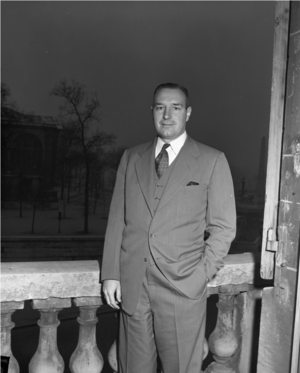Harlan Cleveland
( diplomat) | ||||||||||||||||||||||||||||||
|---|---|---|---|---|---|---|---|---|---|---|---|---|---|---|---|---|---|---|---|---|---|---|---|---|---|---|---|---|---|---|
 | ||||||||||||||||||||||||||||||
| Born | January 19, 1918 | |||||||||||||||||||||||||||||
| Died | May 30, 2008 (Age 90) | |||||||||||||||||||||||||||||
| Nationality | US | |||||||||||||||||||||||||||||
| Alma mater | • Phillips Academy • University College (Oxford) | |||||||||||||||||||||||||||||
| Parents | • Stanley Matthews Cleveland • Marian Van Buren | |||||||||||||||||||||||||||||
| Siblings | • Harold van Buren Cleveland • Stanley Cleveland • Anne Cleveland White | |||||||||||||||||||||||||||||
| Member of | Aspen Institute, Atlantic Council, Bohemian Grove, Club of Rome, Council on Foreign Relations/Historical Members, Rhodes Scholar/1938 | |||||||||||||||||||||||||||||
| Interests | Marshall Plan | |||||||||||||||||||||||||||||
| Party | Democratic | |||||||||||||||||||||||||||||
Attended the 1967 Bilderberg as US Permanent Representative to NATO. CFR, Club of Rome, Atlantic Council, chairman of the Weather Modification Advisory Board...
| ||||||||||||||||||||||||||||||
Harlan B. Cleveland was an American diplomat, futurologist, university rector and writer. He was Assistant Secretary of State for International Organization Affairs between 1961 and 1965.[1] He played a a major role in the administration of the Marshall Plan, was a member of the Council on Foreign Relations and the Club of Rome, vice-chairman of the Atlantic Council, chairman of the Weather Modification Advisory Board. He attended the 1967 Bilderberg meeting, where one of the subjects was Do the basic concepts of Atlantic co-operation remain valid for the evolving world situation?, as US Permanent Representative to NATO.
Education
Harlan Cleveland, the son of Stanley Cleveland and his wife Marian Van Buren, went to Phillips Academy, then studied at Princeton University, graduating in 1938. He also received a Rhodes Scholarship to study at the University of Oxford and worked as an expert on economic warfare at the [Board of Economic Warfare]] 1942-1944[2].
Career
He becaame executive director of the economic section of the Allied Control Commission in Rome (1944-1945); acting vice president of the Allied Control Commission (1945-1946); and deputy chief of the [[United Nations Relief and Rehabilitation Administration[[ (UNRRA) in Italy (1946-1947). In 1947, Cleveland became director of the UNRRA's China program and in 1948 transferred to the United States Economic Cooperation Administration as director of the China aid division, with a $650 million budget, a program that was shut down after the communist takeover of China in 1949.[1]
He played a major role in the administration of the Marshall Plan, managing its fourth year. In the 1950s, he was also the editor and managing editor of The Reporter magazine, a liberal biweekly magazine in New York City, as well Dean of the Maxwell School of Citizenship and Public Affairs at Syracuse University from 1956 to 1961.[2]
On February 20, 1961, Cleveland replaced Francis O. Wilcox as head of the International Organizations subdivision at the US State Department (Assistant Secretary of State for International Organization Affairs) and held this post until September 1, 1965, after which Joseph J. Sisco became his successor.[3] in this position, he was an intermediary between Secretary of State Dean Rusk and U.S. ambassador to the United Nations Adlai Stevenson and was involved in responding to several peace and security crises during that period, including in the Congo, West New Guinea, [[Cyprus], the Middle East, and the Cuban missile crisis. He was also responsible for ensuring that ambassadors to international organizations promoted and protected U.S. interests and for selecting the U.S. delegation for any international projects or conferences.
He himself then replaced Thomas K. Finletter as US Permanent Representative to NATO on 1 September 1965 and held this post until his replacement by Robert Fred Ellsworth on 11 September. June 1969.<ref>https://history.state.gov/departmenthistory/people/chiefsofmission/representative-to-nato<ref> He was also chairman of the Antarctic Policy Group at the Ministry of Foreign Affairs. The Cleveland Mesa, an 8 km long and 5 km wide plateau in the West Antarctic Marie Byrd Land, was named in his honor in 1967.[2]
Subsequently, Cleveland became president of the University of Hawaii at Mānoa in 1969 and was then president of the University of Hawaii System from 1972 until his replacement by Fujio Matsuda in 1974. He was also the dean of the Humphrey School of Public Affairs at the University of Minnesota. He was chairman of the Weather Modification Advisory Board from 1977 to 1978 and was Vice-Chairman o of the Atlantic Council, a Fellow of the International Leadership Forum and the American Academy of Diplomacy, a member of the Club of Rome, the Council on Foreign Relations and the Aspen Institute. [2]
He was a columnist for the Minneapolis-based daily Star Tribune from 1987 to 1993 and became president of the World Academy of Art and Science (WAAS) In 1991, he was given the Presidential Medal of Freedom.
He had two daughters, Zoë and Melantha, and a son, Alan Cleveland, from his marriage to Lois Cleveland, to whom he was married until his death.
Event Participated in
| Event | Start | End | Location(s) | Description |
|---|---|---|---|---|
| Bilderberg/1967 | 31 March 1967 | 2 April 1967 | UK Cambridge University/St John's College | Possibly the only Bilderberg meeting held in a university college rather than a hotel (St. John's College, Cambridge) |